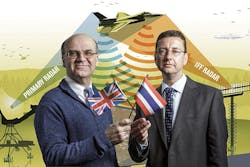Royal Thai Air Force boosts air defense with enhanced processing and displays, avoids expensive sensor upgrade
CAMBRIDGE, U.K., 2 June 2015. Engineers at the Royal Thai Air Force (RTAF) headquarters at Don Muang Airbase, Bangkok, Thailand, sought a cost-effective upgrade to legacy air defense processing and display hardware without replacing the existing and expensive radar sensors. They found their solution at Cambridge Pixel, a developer of radar display and tracking subsystems, in Cambridge, United Kingdom.
RTAF engineers elected to upgrade its air defence capability at several strategic sites across Thailand, including air force bases and training facilities. A key requirement was to reduce long-term maintenance costs by using commercially off-the-shelf (COTS) products while adding new tracking, safety, and display features, such as improved target tracking from both the primary and identification friend or foe (IFF) sensors, track fusion, safety alerts, and presentation of the integrated data on a large, clear plan position indicator (PPI) display on top of user-selectable maps.
The Royal Thai Air Force selected Cambridge Pixel’s solution because it employed the existing sensors, saving considerable costs, while upgrading the processing and display to provide the enhanced capabilities needed in a modern implementation.
Commenting on the project, Group Captain Thouchpong, said: “We were very pleased with Cambridge Pixel. Their engineers understood what we needed and provided excellent support during the installation and deployment of the first two sites at Udon Thani and Nakhon Pathom. We now have an upgraded capability based on COTS products, which promises reduced long-term maintenance costs. We are looking forward to continuing the collaboration by upgrading the air defence systems at our other airbase facilities.”
Cambridge Pixel has supplied RTAF with its radar processing and tracking products which interface to the existing primary and secondary (IFF) radars to provide upgraded target tracking from the primary and IFF sensors and fusion into a single track source. The display is handled by Cambridge Pixel’s ASD-100 air situation display software, which provides an integrated display picture of primary and secondary video and tracks that are overlaid on maps. The software runs on standard PC hardware, thereby reducing costs of maintaining the system.
“By combining our software modules for target tracking and fusion with our ASD-100 display application, we have offered a highly cost-effective upgrade to RTAF. For this project it was important that we could work with the existing radars, and our range of hardware interface cards and radar processing modules was a good match for the requirement,” says David Johnson, CEO of Cambridge Pixel.
The company’s ASD-100 air situation display provides an operator with a complete and integrated picture of everything in the skies, military or commercial air traffic, whether friend or foe. This application can interface to a number of different ASTERIX data inputs including CAT-240 (radar video), CAT-48 (track reports), and CAT-4 (safety alert messages). Safety alerts such as short-term conflict alerts, area proximity warnings, and minimum safety altitude warnings may be sent to the ASD-100 display using Cambridge Pixel’s SPx SafetyNet server application.
Cambridge Pixel’s hardware-agnostic SPx suite of software libraries and applications provide flexible, ready-to-run software products or “modules-of-expertise” for radar visualisation, radar video distribution, plot extraction, target tracking, and fusion, a company spokesperson explains.
Cambridge Pixel’s technology is used in naval, air traffic control, vessel traffic, commercial shipping, security, surveillance, and airborne radar applications. Its systems have been implemented in mission-critical applications with companies such as BAE Systems, Frontier Electronic Systems, Barco Defense, Blighter Surveillance Systems, DRS, Exelis, Kelvin Hughes, Lockheed Martin, Navtech Radar, Raytheon, Samsung Thales, Sofresud and Tellumat.
Founded in 2007, Cambridge Pixel is a specialist developer of sensor processing and display solutions including primary and secondary radar interfacing, processing, and display components for military and commercial radar applications. It is a supplier of software-based radar tracking and scan conversion solutions through its modular SPx software, and HPx hardware product range.

